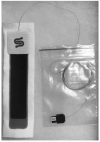Fatigue Testing of Wearable Sensing Technologies: Issues and Opportunities
- PMID: 34361264
- PMCID: PMC8347841
- DOI: 10.3390/ma14154070
Fatigue Testing of Wearable Sensing Technologies: Issues and Opportunities
Abstract
Standards for the fatigue testing of wearable sensing technologies are lacking. The majority of published fatigue tests for wearable sensors are performed on proof-of-concept stretch sensors fabricated from a variety of materials. Due to their flexibility and stretchability, polymers are often used in the fabrication of wearable sensors. Other materials, including textiles, carbon nanotubes, graphene, and conductive metals or inks, may be used in conjunction with polymers to fabricate wearable sensors. Depending on the combination of the materials used, the fatigue behaviors of wearable sensors can vary. Additionally, fatigue testing methodologies for the sensors also vary, with most tests focusing only on the low-cycle fatigue (LCF) regime, and few sensors are cycled until failure or runout are achieved. Fatigue life predictions of wearable sensors are also lacking. These issues make direct comparisons of wearable sensors difficult. To facilitate direct comparisons of wearable sensors and to move proof-of-concept sensors from "bench to bedside", fatigue testing standards should be established. Further, both high-cycle fatigue (HCF) and failure data are needed to determine the appropriateness in the use, modification, development, and validation of fatigue life prediction models and to further the understanding of how cracks initiate and propagate in wearable sensing technologies.
Keywords: cyclic softening; cyclic testing; fatigue testing; fatigue testing standards; high-cycle fatigue; hysteresis; lead failure; low-cycle fatigue; stretch sensor; wearables.
Conflict of interest statement
The authors declare no conflict of interest.
Figures







References
-
- Wang F., Liu S., Shu L., Tao X.-M. Low-Dimensional Carbon Based Sensors and Sensing Network for Wearable Health and Environmental Monitoring. Carbon. 2017;121:353–367. doi: 10.1016/j.carbon.2017.06.006. - DOI
-
- Carvalho H., Catarino A.P., Rocha A., Postolache O. Health Monitoring Using Textile Sensors and Electrodes: An Overview and Integration of Technologies; Proceedings of the 2014 IEEE International Symposium on Medical Measurements and Applications (MeMeA); Lisbon, Portugal. 11 June 2014; pp. 1–6.
-
- Hehr A., Song Y., Suberu B., Sullivan J., Shanov V., Schulz M. Chapter 24—Embedded Carbon Nanotube Sensor Thread for Structural Health Monitoring and Strain Sensing of Composite Materials. In: Schulz M.J., Shanov V.N., Yin Z., editors. Nanotube Superfiber Materials. William Andrew Publishing; Boston, MA, USA: 2014. pp. 671–712.
Publication types
Grants and funding
LinkOut - more resources
Full Text Sources
Research Materials

